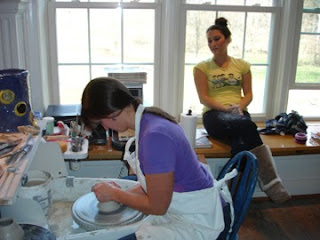In the latest issue of Claytimes there is an article about a tool that facilitates making hexagon and octagon shaped pots. That sounded right up my alley because mandalas/kaleidoscopes are special to me and the divisions of a circle into equal sections is a basic step in that process. I love the angles and repetitions.
Problem was I didn’t have the patience to wait for my busy woodworking husband to find the time to make one for me. Wandering through the studio I laid eyes on some of that big 2” block insulation---hmmm, foam, easy to cut….need a saw. Scanned the room, which is also his woodworking section of the building; couldn’t find a saw. Typically easily defeated, I gave up the idea. Or so I thought.
Couldn’t believe there wasn’t a hand saw in there among all those other tools so I went to look again. Voila! Hanging on a nail on the wall! I was in business.
I went to my wheel and got my little paper protractor from my tool cup and promptly marked off a 60 degree angle on the edge of the insulation. With four roofing nails on one side and four drywall screws on the other I “nailed” the thing to the side of another piece of insulation.
I marked off a 45 degree on the edge of another piece and did the same thing. They’re not pretty, but they did the job well enough for me to know how they work and that they work. I see now that they don’t need to be so long, (This very same day I found the lost magazine that contained the article. Serendipity.)
I also feel that since I have drawn the lines of division on the bat, I should be able to create the geometric forms by pushing out on the lines and in against the side with something flat. I’m glad I found the article because I seldom recall all the details, like “put a slip of wet newspaper on the clay so the angle tool does not stick”. It’s the details that’ll get ya.
So, here are the jerry-rigged angle tools: Pretty clunky to say the least!
And here are the two prototype pots:
I kind of like the marks made by the roofing nails...
When I was in Adobe resizing these photos, I could see the details and found myself trying to use the computer program to correct the imperfections on the pots as if I had a sponge in my hand…I had to smile.
And here is the last pot to be made of the first ever batch of Standard 266 brown clay. I think I love it.
Cleaned up the pottery corner, washed all the tools, vacuumed the floor, and brought in fresh water. Now, on to the S213 midrange porcelain--another new adventure.
ttfn mec
































